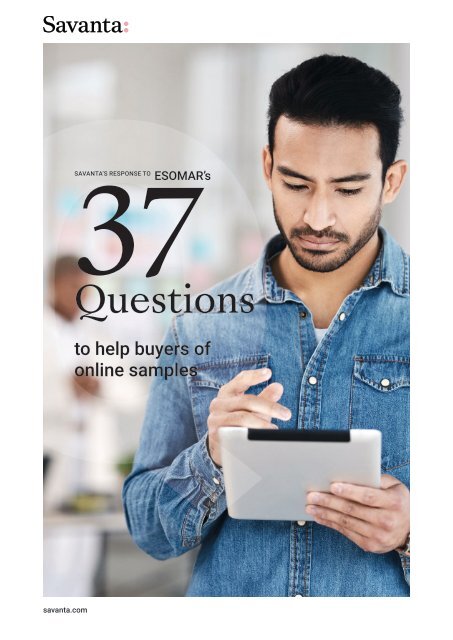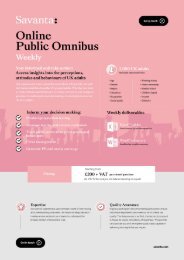Savanta_37_online_sample_questions_US
Create successful ePaper yourself
Turn your PDF publications into a flip-book with our unique Google optimized e-Paper software.
SAVANTA’S RESPONSE TO<br />
ESOMAR’s<br />
<strong>37</strong><br />
Questions<br />
to help buyers of<br />
<strong>online</strong> <strong>sample</strong>s<br />
savanta.com
<strong>37</strong> QUESTIONS TO HELP BUYERS OF ONLINE SAMPLES<br />
Contents<br />
Company profile<br />
Sample sources and recruitment<br />
Sampling and project management<br />
Data quality and validation<br />
Policies and compliance<br />
Metrics<br />
3<br />
4<br />
6<br />
12<br />
15<br />
16<br />
savanta.com<br />
2
<strong>37</strong> QUESTIONS TO HELP BUYERS OF ONLINE SAMPLES<br />
Company profile<br />
1. What experience does your company have in providing <strong>online</strong> <strong>sample</strong>s for<br />
market research? How long have you been providing this service? Do you<br />
also provide similar services for other uses, such as direct marketing? If<br />
so, what proportion of your work is for market research?<br />
<strong>Savanta</strong> has extensive experience in providing <strong>sample</strong>s for market research through<br />
our proprietary panels and our extensive supplier network. <strong>Savanta</strong> now owns three<br />
proprietary panels - Crowdology, The OpinionPanel Community, and the app based<br />
YourVue panel. The OpinionPanel Community was established in 2004 and, since its<br />
inception, has been available as a leading resource for accessing youth <strong>sample</strong>s <strong>online</strong>.<br />
<strong>Savanta</strong> does not provide services other than those associated with market research, and<br />
as a matter of principle, we do not market or sell to our panelists.<br />
2. Do you have staff with responsibility for developing and monitoring the<br />
performance of the sampling algorithms and related automated functions<br />
who also have knowledge and experience in this area? What sort of training<br />
in sampling techniques do you provide to your frontline staff?Sampling is<br />
managed by the dedicated Operations team, and panel management is led by our Audience<br />
team. Staff are trained on the implementation of internal panel assets and external<br />
sampling tools to ensure consistency of sampling. The Audience team periodically<br />
monitors panel health to ensure responsiveness, quality, and feasibility.<br />
For the external tools, sampling process and associated algorithms are managed by the<br />
supplier DSPs.<br />
3. What other services do you offer? Do you cover <strong>sample</strong>-only, or do you<br />
offer a broad range of data collection and analysis services?<br />
<strong>Savanta</strong> offers a range of data collection options. External buyers can reach our internal<br />
members by either managed <strong>sample</strong> only research, or through full service projects on a<br />
quantitative or qualitative basis.<br />
savanta.com<br />
3
<strong>37</strong> QUESTIONS TO HELP BUYERS OF ONLINE SAMPLES<br />
Sample sources and recruitment<br />
4. Using the broad classifications, from what sources of <strong>online</strong> <strong>sample</strong> do<br />
you derive participants?<br />
For our internal <strong>sample</strong> in the UK, <strong>US</strong>, and the Netherlands the panel uses a mixture of<br />
paid recruitment using external partners, alongside organic panel growth. We operate<br />
internal research assets as a general population, and as such, is open to all who pass the<br />
QA and fraud detection processes.<br />
Our recruitment partners largely work on a lead generation basis, using paid media<br />
channels to encourage prospective panelists to opt in as a panelist.<br />
We are also exploring using our own in-house paid media strategy using channels such as<br />
Google Ads.<br />
Currently we are not making use of any referral or affiliate programs. We do not make use<br />
of any intercepts for sampling.<br />
5. Which of these sources are proprietary or exclusive, and what is the<br />
percent share of each in the total <strong>sample</strong> provided to a buyer?<br />
For our internal assets, to build our panels to have high feasibility and quality, we typically<br />
will partner with a range of commercial partners as listed above for our panel building.<br />
These will typically be on a non-exclusive basis.<br />
However, we are developing our in-house proprietary marketing strategy.<br />
6. What recruitment channels are you using for each of the sources you have<br />
described? Is the recruitment process ‘open to all’ or by invitation only?<br />
Are you using probabilistic methods? Are you using affiliate networks and<br />
referral programs, and in what proportions? How does your use of these<br />
channels vary by geography?<br />
Our main internal assets are OPC, Crowdology, and YourVue. Membership of OPC is<br />
demographically restricted to those aged 18-30 in the UK with a core focus on students.<br />
Within those demographics, recruitment is open to all who pass the QA requirements.<br />
We have proprietary in-house marketing channels, and also make use of third-party<br />
partners to grow our panel assets.<br />
We are not currently making use of probabilistic methods, affiliate networks, or referral<br />
programs.<br />
savanta.com<br />
4
<strong>37</strong> QUESTIONS TO HELP BUYERS OF ONLINE SAMPLES<br />
Sample sources and recruitment<br />
7. What form of validation do you use in recruitment to ensure that<br />
participants are real, unique, and are who they say they are?<br />
For our identity verification & fraud detection strategy we use a combination of technical<br />
and analytical solutions. On registration, users are validated using the Imperium RegGuard<br />
fraud detection tool.<br />
Those that successfully validate are checked by the Audience team on signals, including<br />
user profile and survey quality metrics over time.<br />
Additionally, all internal research includes the Imperium Relevant ID fraud detection tool.<br />
There are feedback systems in place with internal research teams to remove poor-quality<br />
respondents from the panel.<br />
8. What brand (domain) and/or app are you using with proprietary sources?<br />
Our current proprietary sources are:<br />
1 - Crowdology - crowdology.com<br />
2 - The OpinionPanel Community - opinionpanel.co.uk<br />
3 - YourVue (App)<br />
• Play Store<br />
• App Store<br />
9. Which model(s) do you offer to deliver <strong>sample</strong>? Managed service, selfserve,<br />
or API integration?<br />
Buyers can access <strong>sample</strong> on a managed <strong>sample</strong> only or full-service basis.<br />
10. If offering intercepts or providing access to more than one source, what<br />
level of transparency do you offer over the composition of your <strong>sample</strong><br />
(<strong>sample</strong> sources, <strong>sample</strong> providers included in the blend). Do you let<br />
buyers control which sources of <strong>sample</strong> to include in their projects, and if<br />
so, how? Do you have any integration mechanisms with third-party sources<br />
offered?<br />
We do not currently make use of intercepts for sampling.<br />
savanta.com<br />
5
<strong>37</strong> QUESTIONS TO HELP BUYERS OF ONLINE SAMPLES<br />
Sample sources and recruitment<br />
11. Of the <strong>sample</strong> sources you have available, how would you describe the<br />
suitability of each for different research applications?<br />
<strong>Savanta</strong> provides a flexible approach to respondent participation in studies. Our members<br />
have the ability to opt in or out of specific research types, ensuring that only interested<br />
respondents are invited. For recall studies, clients can collect personally identifiable<br />
information (PII) from respondents, and our management system can identify past<br />
participants for unforeseen recontacts.<br />
We carefully select <strong>sample</strong> sources to ensure suitability for each project. Our unique<br />
blend of supply and respondent access allows us to support a wide range of quantitative<br />
and qualitative projects, including IHUTs, focus groups, recontacts, and consumer and<br />
brand health trackers. Our surveys are fully compatible and optimized for both desktop<br />
and mobile use, enabling panelists to participate through their preferred channel, whether<br />
it’s a mobile app, website, or email invitation. We determine the best channels for each<br />
project based on user experience and device compatibility.<br />
savanta.com<br />
6
<strong>37</strong> QUESTIONS TO HELP BUYERS OF ONLINE SAMPLES<br />
Sampling and project management<br />
12. Briefly describe your overall process from invitation to survey completion.<br />
What steps do you take to achieve a <strong>sample</strong> that “looks like” the target<br />
population? What demographic quota controls, if any, do you recommend?<br />
Panelists or participants can be invited to join through direct emails or by clicking on<br />
a link provided on a website or application. Every invitation includes the opportunity to<br />
take the survey, details about the incentive, an estimated completion time, terms and<br />
conditions, privacy policy, and the option to opt-out, along with explicit instructions on<br />
how to start the survey, and a link to begin.<br />
When starting the survey, respondents are required to meet certain criteria through<br />
screening <strong>questions</strong>. Once they have met the criteria, they must answer all mandatory<br />
<strong>questions</strong> in the survey and submit their responses to receive the incentive.<br />
<strong>Savanta</strong> uses nationally representative quota controls based on the latest census<br />
data, to ensure that the <strong>sample</strong> population accurately reflects the demographics of the<br />
entire country. This approach helps to minimize bias and ensure the findings are more<br />
generalizable to the overall population.<br />
If more targeted groupings are required, <strong>Savanta</strong> will collaborate with the client to create<br />
quotas that work for their required audience. For example, if the research is focused on<br />
a specific region or demographic group, client-specified quotas can be set to ensure an<br />
adequate representation of that particular group.<br />
<strong>Savanta</strong> will use interlocked quotas when multiple demographic variables need to be<br />
controlled simultaneously. This allows for greater precision in selecting participants who<br />
match specific combinations of demographics. Non-interlocked quotas are used when<br />
only one demographic variable needs to be controlled, such as age or gender.<br />
Overall, the choice between nationally representative or client-specified quotas and<br />
nested or non-nested structures depends on the specific objectives and requirements of<br />
the research project. It is important to carefully consider these factors in order to ensure<br />
the <strong>sample</strong> is representative and the study outcomes are reliable.<br />
savanta.com<br />
7
<strong>37</strong> QUESTIONS TO HELP BUYERS OF ONLINE SAMPLES<br />
Sampling and project management<br />
13. What profiling information do you hold on at least 80% of your panel<br />
members, plus any intercepts known to you through prior contact? How<br />
does this differ by the sources you offer? How often is each of those data<br />
points updated? Can you supply these data points as appends to the data<br />
set? Do you collect this profiling information directly, or is it supplied by a<br />
thirdparty?<br />
Upon registration, all users initially supply core profile information of name, email, gender,<br />
age & region.<br />
Additional profiling is conducted as users complete studies. Users are presented with<br />
different profiling modules at the start of surveys for qualification purposes and profiling.<br />
Users are also able to update their profiling information via the user portal. We do not<br />
make use of any intercepts or third part profiling.<br />
There is no mechanism to attach additional profiling points to a study retrospectively.<br />
14. What information do you need about a project in order to provide an<br />
estimate of feasibility? What, if anything, do you do to give upper or lower<br />
boundaries around these estimates?<br />
As a panel expert, several crucial pieces of information are necessary for us to furnish<br />
a comprehensive estimate of project feasibility. Key details include understanding the<br />
demographics of the target audience, specifying the geographic location of the study,<br />
determining the anticipated length of the survey, and addressing any unique requirements<br />
articulated by our clients. Additionally, factors such as the incidence rate, quotas, device<br />
requirements for the survey, and the complexity of the project play pivotal roles in our<br />
feasibility assessment.<br />
Utilizing historical data, we offer mid-range costings that provide a balanced perspective<br />
on project feasibility. Throughout the fieldwork phase, our team maintains vigilant<br />
monitoring to ensure ongoing alignment with initial estimates. This involves regular<br />
progress checks and a proactive stance in addressing any deviations that may arise<br />
during the project.<br />
This ensures that estimates remain accurate and reflective of the evolving project<br />
dynamics. Our commitment to adaptability allows us to respond effectively to changing<br />
circumstances, safeguarding the project’s feasibility throughout its lifecycle.<br />
savanta.com<br />
8
<strong>37</strong> QUESTIONS TO HELP BUYERS OF ONLINE SAMPLES<br />
Sampling and project management<br />
15. What do you do if the project proves impossible for you to complete<br />
in field? Do you inform the <strong>sample</strong> buyer as to who you would use to<br />
complete the project? In such circumstances, how do you maintain and<br />
certify third-party sources/sub-contractors?<br />
In our commitment to delivering exceptional results, we prioritize open and transparent<br />
communication with our clients. We understand that effective collaboration is key to<br />
success, and we value our client’s input throughout the entire process.<br />
When we cannot find sufficient respondents from our own panels or from countries<br />
where we lack an internal panel, we rely on third-party <strong>sample</strong> partners. We assess these<br />
partners based on their recruitment methods, data quality controls, and adherence to<br />
industry standards and regulations. We prioritize partners who can provide a diverse<br />
and representative <strong>sample</strong>, ensuring that our research accurately reflects the target<br />
population.<br />
By collaborating with trusted third-party partners, we can expand our reach and access<br />
respondents from a wider range of demographics and geographic locations. This enables<br />
us to provide more comprehensive and insightful market research reports to our clients.<br />
16. Do you employ a survey router or any yield management techniques? If<br />
yes, please describe how you go about allocating participants to surveys.<br />
How are potential participants asked to participate in a study? Please<br />
specify how this is done for each of the sources you offer.<br />
<strong>Savanta</strong> does not employ a survey router, but we collaborate with reputable third-party<br />
panel providers who utilize these tools as part of their survey management techniques.<br />
These panel providers have established large and diverse respondent panels, which are<br />
comprised of individuals who have chosen to participate in market research studies. The<br />
survey routers help these providers to identify and invite suitable participants for each<br />
survey project, ensuring that the surveys reach the intended target audience.<br />
17. Do you set limits on the amount of time a participant can be in the router<br />
before they qualify for a survey?<br />
<strong>Savanta</strong> does not directly utilize a survey router in its operations.<br />
savanta.com<br />
9
<strong>37</strong> QUESTIONS TO HELP BUYERS OF ONLINE SAMPLES<br />
Sampling and project management<br />
18. What information about a project is given to potential participants before<br />
they choose whether to take the survey or not? How does this differ by the<br />
sources you offer?<br />
Respondents are invited via email to projects in which they are <strong>sample</strong>d. They are given<br />
key information on the project, including incentive, assumed LOI, and potential IR.<br />
19. Do you allow participants to choose a survey from a selection of available<br />
surveys? If so, what are they told about each survey that helps them to<br />
make that choice?<br />
Respondents are invited to all projects for which they are <strong>sample</strong>d via email. They are<br />
able to do as many or as few as they wish without penalty. Our panelists also have the<br />
option to log into the user portal and view/ take any surveys available to them.<br />
20. What ability do you have to increase (or decrease) incentives being<br />
offered to potential participants (or sub-groups of participants) during the<br />
course of a survey? If so, can this be flagged at the participant level in the<br />
dataset?<br />
Incentives are largely set algorithmically depending on the survey length of interview<br />
for our internal assets. This is to maintain consistency in our user experience. For our<br />
external sampling the incentive would be managed by the <strong>sample</strong> marketplace who may<br />
adjust the incentive levels depending on LOI, IR, and fieldwork needs.<br />
21. Do you measure participant satisfaction at the individual project level? If<br />
so, can you provide normative data for similar projects (by length, by type,<br />
by subject, by target group)?<br />
Survey takers are given the opportunity to give open-text answers at the end of all<br />
<strong>Savanta</strong> surveys. For our internal assets, we collect data periodically through feedback<br />
surveys and also offer the opportunity to give feedback on unsubscribing.<br />
savanta.com<br />
10
<strong>37</strong> QUESTIONS TO HELP BUYERS OF ONLINE SAMPLES<br />
Sampling and project management<br />
22. Do you provide a debrief report about a project after it has completed? If<br />
yes, can you provide an example?<br />
<strong>Savanta</strong> provides real-time access to survey results and demographic data for projects<br />
programed in the <strong>Savanta</strong> platform. Customers can analyze their data using the AllVue<br />
platform at any point during the project, enabling them to create cross breaks, charts, and<br />
export the data. For surveys not programed in the <strong>Savanta</strong> platform, <strong>Savanta</strong> can provide<br />
bespoke reports as requested by the client based on the following metrics:<br />
• Total starts<br />
• Completes<br />
• Screen outs<br />
• Over quota<br />
• Quality fail<br />
• Drop out<br />
• Country<br />
• Completion rate<br />
• Incidence rate<br />
• Length of interview<br />
• Device used<br />
savanta.com<br />
11
<strong>37</strong> QUESTIONS TO HELP BUYERS OF ONLINE SAMPLES<br />
Data quality and validation<br />
23. How often can the same individual participate in a survey? How does this<br />
vary across your <strong>sample</strong> sources? What is the mean and maximum amount<br />
of time a person may have already been taking surveys before they entered<br />
this survey? How do you manage this?<br />
Individual levels of survey participation will depend on passing the internal and<br />
external quality assurance measures. On all of our surveys, we make use of technical<br />
de-duplication tools with device fingerprinting to prevent the same respondent from<br />
accessing the same surveys. On our proprietary tool, more widely, users are assessed<br />
technically and manually for quality measures.<br />
24. What data do you maintain on individual participants such as recent<br />
participation history, date(s) of entry, source/channel, etc? Are you able to<br />
supply buyers with a project analysis of such individual level data? Are you<br />
able to append such data points to your participant records?<br />
As part of our quality assurance measure, we are able to view individual survey data at<br />
an aggregate and micro level. This information will be used to assess eligibility for survey<br />
participation and membership of our internal assets.<br />
25. Please describe your procedures for confirmation of participant identity<br />
at the project level. Please describe these procedures as they are<br />
implemented at the point of entry to a survey or router.<br />
We have implemented various security measures during the registration and survey entry<br />
process to ensure that our respondents are genuine and authentic. These measures<br />
include duplicate IP prevention, reCAPTCHA, digital fingerprinting, duplicate email<br />
detection, VPN blocking, and double opt-in. When respondents enter the survey, their data<br />
is encrypted to protect their privacy. Along with reCAPTCHA and digital fingerprinting, we<br />
also use pre-screeners to verify the integrity and authenticity of the data. Furthermore,<br />
our panel management platform monitors and identifies speeders, straight-liners, and<br />
poor verbatim responses, generating a report for the operations and panel teams to take<br />
appropriate action.<br />
savanta.com<br />
12
<strong>37</strong> QUESTIONS TO HELP BUYERS OF ONLINE SAMPLES<br />
Data quality and validation<br />
26. How do you manage source consistency and blend at the project<br />
level? With regard to trackers, how do you ensure that the nature and<br />
composition of <strong>sample</strong> sources remain the same over time? Do you have<br />
reports on blends and sources that can be provided to buyers? Can source<br />
be appended to the participant data records?<br />
<strong>Savanta</strong> carefully selects a combination of survey participants for each project, taking<br />
into consideration the specific requirements of the project. When it is important to<br />
compare survey results with previous studies or database norms, <strong>Savanta</strong> pays close<br />
attention to managing the selection process in order to maintain consistency over<br />
time. This is crucial because any changes in the sources or the contribution from those<br />
sources can affect the data.<br />
For tracking projects, the aim is to consistently maintain a balanced blend of participants<br />
throughout the agreed-upon period and avoid any unexpected changes that could impact<br />
the data. <strong>Savanta</strong> follows industry best practices by managing quotas by supplier,<br />
ensuring a consistent pool of participants from each source in the blend. The feasibility<br />
of the participant blend is thoroughly assessed throughout the project’s lifecycle, taking<br />
into account any exclusion periods to ensure the project’s long-term sustainability.<br />
Blend reports, along with panel sources, can be provided and appended to individual<br />
participant data records upon request.<br />
27. Please describe your participant/member quality tracking, along with<br />
any health metrics you maintain on members/participants, and how<br />
those metrics are used to invite, track, quarantine, and block people from<br />
entering the platform, router, or a survey. What processes do you have in<br />
place to compare profiled and known data to in-survey responses?<br />
Respondents survey metrics, including the percentage of survey fails by our research<br />
tech anti-fraud technology, and the percentage of removals from surveys, are tracked<br />
alongside other health metrics at an individual and aggregate level. This data is used to<br />
block entry to individual surveys and to facilitate the procedural panel quality assurance<br />
processes. The operations and research teams work in conjunction to ensure the validity<br />
of the data and respondents.<br />
savanta.com<br />
13
<strong>37</strong> QUESTIONS TO HELP BUYERS OF ONLINE SAMPLES<br />
Data quality and validation<br />
28. For work where you program, host, and deliver the survey data, what<br />
processes do you have in place to reduce or eliminate undesired in-survey<br />
behaviors, such as (a) random responding, (b) illogical or inconsistent<br />
responding, (c) overuse of item non-response (e.g., “Don’t Know”) (d)<br />
inaccurate or inconsistent responding, (e) incomplete responding, or (f)<br />
too rapid survey completion?<br />
<strong>Savanta</strong> utilizes carefully crafted trap <strong>questions</strong> in surveys to ensure that respondents do<br />
not easily recognize them. We have found that incorporating open-ended trap <strong>questions</strong>,<br />
along with other reliable and high-quality <strong>questions</strong> and checks, helps us maintain the<br />
integrity of our survey data.<br />
In order to maintain the overall quality of our projects, we conduct several general quality<br />
checks, including:<br />
• Open-ended question checks: <strong>Savanta</strong> employs automated checks to identify various<br />
issues such as copied and pasted text, gibberish, obscenities, duplicate responses,<br />
and the length of responses. We also have technology in place to translate open-ended<br />
responses for surveys that are not in English, enabling us to run these automated<br />
checks.<br />
• Overuse of item non-response/straight-liners: We employ automated checks to<br />
identify patterns in responses across specific question types. For example, we look for<br />
instances where respondents repeatedly select the same positive or negative end of a<br />
scale (e.g., “Strongly agree” or “Strongly disagree”), or consistently choose a particular<br />
answer option (e.g., always selecting the first or last option in the answer list).<br />
• Speeding check: <strong>Savanta</strong> identifies and removes respondents who rush through a<br />
survey by assessing their completion time compared to the median question page<br />
completion time. If a respondent spends 33% or less of the median completion time<br />
on more than 40% of the survey pages, they are flagged and excluded from the final<br />
dataset.<br />
These quality checks help us ensure the reliability and validity of our survey responses.<br />
savanta.com<br />
14
<strong>37</strong> QUESTIONS TO HELP BUYERS OF ONLINE SAMPLES<br />
Policies and compliance<br />
29. Please provide the link to your participant privacy notice (sometimes<br />
referred to as a privacy policy) as well as a summary of the key concepts it<br />
addresses.<br />
savanta.com/privacy-policy/<br />
• Personal data must be processed fairly and lawfully with the individual’s consent<br />
• It should only be used for the intended purposes and not further processed in<br />
incompatible ways.<br />
• The data should be relevant, adequate, and accurate, with steps taken to keep it up to<br />
date.<br />
• Personal data should not be retained longer than necessary.<br />
• Measures must be taken to protect against unauthorized processing and loss or<br />
damage<br />
• Data should generally only be processed in the country where the individual is located,<br />
unless the destination has equal or stronger data protection laws. Client approval may<br />
also be necessary.<br />
30. How do you comply with key data protection laws and regulations that<br />
apply in the various jurisdictions in which you operate? How do you<br />
address requirements regarding consent or other legal bases for the<br />
processing of personal data? How do you address requirements for data<br />
breach response, cross-border transfer, and data retention? Have you<br />
appointed a data protection officer?<br />
<strong>Savanta</strong> has offices in the UK, the Netherlands, the <strong>US</strong>A, and Canada, and we have access<br />
to legal and data protection advice via our parent company Next 15 Group’s legal teams<br />
based in the UK and the <strong>US</strong>A. <strong>Savanta</strong> has adopted the EU GDPR as our standard. This<br />
means that we comply with most international standards as well. For research involving<br />
personal data from any countries outside the UK, EU, or Americas, we seek advice from<br />
the Next 15 Data Protection Officer.<br />
31. How can participants provide, manage, and revise consent for the<br />
processing of their personal data? What support channels do you provide<br />
for participants?<br />
<strong>Savanta</strong> provides a dedicated email address, dpo@savanta.com, for participant queries<br />
and DSARs.<br />
savanta.com<br />
15
<strong>37</strong> QUESTIONS TO HELP BUYERS OF ONLINE SAMPLES<br />
Policies and compliance<br />
32. How do you track and comply with other applicable laws and regulations,<br />
such as those that might impact the incentives paid to participants?<br />
As an MRS Company Partner, <strong>Savanta</strong> complies with the MRS Code of Conduct with<br />
regard to incentives and other related regulations. In addition, we have access to legal<br />
and regulatory advice via our parent company Next 15 Group’s legal teams based in the<br />
UK and the <strong>US</strong>A.<br />
33. What is your approach to collecting and processing the personal data of<br />
children and young people? Do you adhere to standards and guidelines<br />
provided by ESOMAR or GRBN member associations? How do you comply<br />
with applicable data protection laws and regulations?<br />
As an MRS Company Partner, <strong>Savanta</strong> complies with the MRS Code of Conduct and<br />
the ICC/ESOMAR International Code with regard to collecting and processing data of<br />
children, young people, and vulnerable participants. This applies to all of our operations,<br />
regardless of the country in which the researchers or the participants are based.<br />
34. Do you implement “data protection by design”(sometimes referred to as<br />
“privacy by design”) in your systems and processes? If so, please describe<br />
how.<br />
All of <strong>Savanta</strong>’s systems and processes are built on the basis of the highest level of data<br />
protection. We are certified to ISO27001 and Cyber Security standards. We have a suite<br />
of policies that all staff are contractually obliged to adhere to, which put information<br />
protection at the center. We conduct compulsory data protection training when staff join,<br />
and access to our systems is conditional on completion of this training. The training is<br />
refreshed annually. We ensure that we have written agreements with all of our clients and<br />
subcontractors that include data protection clauses. We have policies and procedures for<br />
conducting Data Protection Impact Assessments, for completing Data Subject Access<br />
Requests, and for handling breaches.<br />
savanta.com<br />
16
<strong>37</strong> QUESTIONS TO HELP BUYERS OF ONLINE SAMPLES<br />
Policies and compliance<br />
35. What are the key elements of your information security compliance<br />
program? Please specify the framework(s) or auditing procedure(s) you<br />
comply with or certify to. Does your program include an asset-based risk<br />
assessment and internal audit process?<br />
<strong>Savanta</strong> is certified to ISO27001 and Cyber Security standards. We conduct quarterly<br />
internal audits of our ISMS and this is subject to an annual external audit. In addition,<br />
we conduct regular pen tests, and our information security systems are audited by our<br />
clients. We have a risk register, which is updated monthly during the meeting of the<br />
Business Assurance Committee.<br />
36. Do you certify to or comply with a quality framework such as ISO 20252?<br />
<strong>Savanta</strong>’s CATI unit is certified to ISO20252 standards. <strong>Savanta</strong> as a whole complies with<br />
this standard but is not certified.<br />
savanta.com<br />
17
<strong>37</strong> QUESTIONS TO HELP BUYERS OF ONLINE SAMPLES<br />
Metrics<br />
<strong>37</strong>. Which of the following are you able to provide to buyers, in aggregate and<br />
by country and source?<br />
We can provide a range of survey-quality data in aggregate form to buyers. This could<br />
include:<br />
• Qualification rates<br />
• Survey failure rates<br />
• Incidence rates<br />
• Panelists removed from internal assets<br />
All of these can be trended monthly or by country<br />
savanta.com<br />
18
etter.decisions@savanta.com<br />
+44 (0) 20 7632 3434<br />
Amsterdam<br />
Grote Bickersstraat 74-78<br />
1013 KS<br />
Amsterdam<br />
Netherlands<br />
London<br />
60 Great Portland Street<br />
London<br />
W1W 7RT<br />
UK<br />
New York<br />
666 Third Ave.<br />
7th Floor<br />
New York NY 10017<br />
<strong>US</strong>A<br />
savanta.com<br />
Make Better Decisions

















